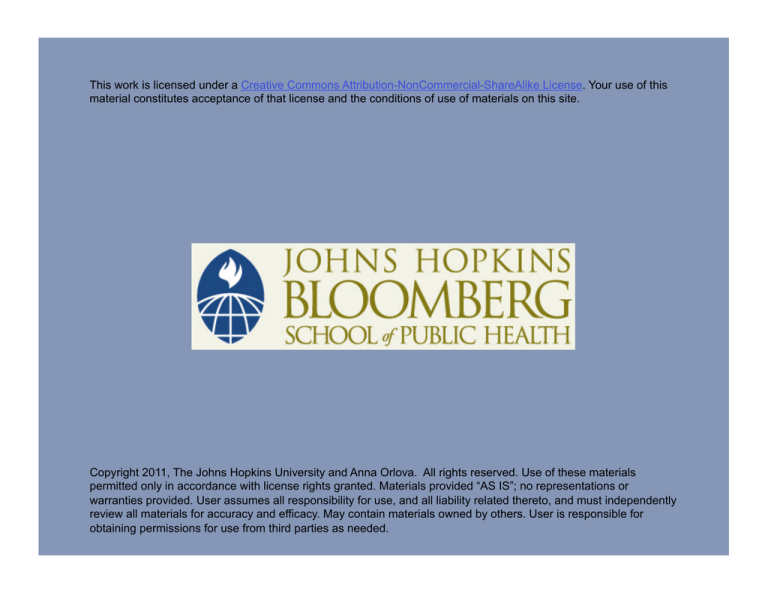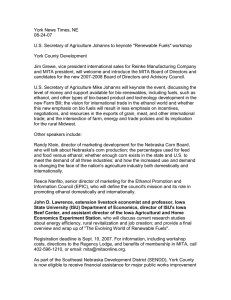
This work is licensed under a Creative Commons Attribution-NonCommercial-ShareAlike License. Your use of this
material constitutes acceptance of that license and the conditions of use of materials on this site.
Copyright 2011, The Johns Hopkins University and Anna Orlova. All rights reserved. Use of these materials
permitted only in accordance with license rights granted. Materials provided “AS IS”; no representations or
warranties provided. User assumes all responsibility for use, and all liability related thereto, and must independently
review all materials for accuracy and efficacy. May contain materials owned by others. User is responsible for
obtaining permissions for use from third parties as needed.
Section D
From Business Processes to Systems Requirements
From Business Processes to Systems Requirements
“Defining system requirements is the most
important step in developing or acquiring any
information system. A well-conceived and planned
health information system can help organizations
understand the need to adjust tasks or processes
to be more effective or proactive in protecting
community health …”
Source: URL:http://www.phii.org/subjectareas/requirementsdevelopment.asp
3
Health Department: Organizational Chart
4
EHR-S: Public Health (PH) IS Features
5
EHR-S: Public Health (PH) IS Features
6
EHR-S: Public Health (PH) IS Features
7
EHR-S: Public Health (PH) IS Features
8
Common Grounds Project: Cabbarus Health Alliance
Use case scenarios were developed to guide vendors in
demonstrating their products to ensure the most important features
and functionality were viewed by the project team
-
-
-
-
-
-
Use Case: Child Health
Use Case: Family Planning
Use Case: Maternal Care Coordination
Use Case: Maternal Health
Use Case: Sexually Transmitted Disease
Use Case: Tuberculosis
Source: http://www.cabarrushealth.org/CommonGround/Methodology/index.htm
9
AHIC National Use Cases: 2006–2009
10
Meaningful Use of Health IT Use Cases: 2011–2016
2015–2016
Future CMS rule
2013–2016
Future CMS rule
2011–2012
Current CMS NPRM
Source: W. Suarez, et al. “Review of CMS Meaningful Use NPRM and ONC Standards and Certification IFR:
Implications for Public Health.” Presentation at JPHIT-PHDSC Webinar, February 4, 2010. Public Domain.
11
Public Health and Clinical Information Exchanges
Developer View = Transactions
Syste
m
System
Syste
m
System
Syste
m
System
Syste
m
System
Source: (2009). HITSP. Public Domain.
12
Building a Consensus
Building a Consensus on Public
Health High-Level Business Areas
13
Learning from CMS MITA
Medicaid Information Technology Architecture (MITA)
CMS believed that the majority of business processes in Medicaid
were similar—i.e., paying claims was universal
Business processes are intended to be processes and are not
represented by programs or organizational structure
Focus groups with multiple states developed eight common business
areas and 79 common business processes
If business processes are similar, then standard modules could be
developed and implemented in each state and from state to state
Source: Klein S. and Hohner V. (Nov.4, 2010.) MITA Lessons. Presentation. 2010 PHDSC Annual Business Meeting,
Hyattsville MD. http://www.phdsc.org/about/annual-2010-presentations.asp#day2
14
Learning from CMS MITA
A modular approach could allow states to upgrade incrementally
and move away from the big black box approach to the Medicaid
Management Information System (MMIS)
A business process should describe most of the commonality among
states, but states may have some modifications
State modifications to each module would generally not be
extensive
All new requests for federal funding must demonstrate that it will
improve the maturity, or capabilities, of these business processes
Source: Klein S. and Hohner V. (Nov.4, 2010.) MITA Lessons. Presentation. 2010 PHDSC Annual Business Meeting,
Hyattsville MD. http://www.phdsc.org/about/annual-2010-presentations.asp#day2
15
MITA Business Areas
Contractor management
—9 BPs
Member management—8
BPs
Provider management—7
BPs
Operations management—
26 BPs
Program integrity
management—2 BPs
Care management—4 BPs
Program management—
19 BPs
Business relationship
management—4 BPs
Source: Klein S. and Hohner V. (Nov.4, 2010.) MITA Lessons. Presentation. 2010 PHDSC Annual Business Meeting,
Hyattsville MD. http://www.phdsc.org/about/annual-2010-presentations.asp#day2
16
MITA Business Areas
Contractor management
—9 BPs
Member management—8
BPs
Provider management—7
BPs
Operations management—
26 BPs
Program integrity
management—2 BPs
Care management—4 BPs
Program management—
19 BPs
Business relationship
management—4 BPs
Source: Klein S. and Hohner V. (Nov.4, 2010.) MITA Lessons. Presentation. 2010 PHDSC Annual Business Meeting,
Hyattsville MD. http://www.phdsc.org/about/annual-2010-presentations.asp#day2
17
Member Management: Tasks
Determine eligibility
Enroll member
Disenroll member
Manage applicant and member communication
Manage member grievance and appeal
Manage member information
Perform population and member outreach
Source: Klein S. and Hohner V. (Nov.4, 2010.) MITA Lessons. Presentation. 2010 PHDSC Annual Business Meeting,
Hyattsville MD. http://www.phdsc.org/about/annual-2010-presentations.asp#day2
18
Learning from CMS MITA
The MITA concept is included
in HITECH Meaningful Use rules
and is a focus for HHS
Standardized data can be
accumulated and analyzed
more quickly to speed CMS
activities
Reduces silos; systems are
expensive and resources are
limited
Facilitates interoperability of
information systems within the
agency and with other health
care systems
Facilitates cross state
communications
Standardized applications can
be implemented more quickly,
inexpensively, and in more
locations
Source: Klein S. and Hohner V. (Nov.4, 2010.) MITA Lessons. Presentation. 2010 PHDSC Annual Business Meeting,
Hyattsville MD. http://www.phdsc.org/about/annual-2010-presentations.asp#day2
19
MITA Concepts and Public Health
What large business areas are universal across local and state public
health agencies and across public health programs?
What smaller business processes would also be similar across such
agencies and programs?
Could enough commonality be found or agreed upon that would
enable modular system components that could proceed toward
meaningful use requirements?
What would it take to get public health agencies to participate to
create such a concept?
Source: Klein S. and Hohner V. (Nov.4, 2010.) MITA Lessons. Presentation. 2010 PHDSC Annual Business Meeting,
Hyattsville MD. http://www.phdsc.org/about/annual-2010-presentations.asp#day2
20
Learning from CMS MITA
It is difficult to arrive at a
consensus among 50+ states/
territories and about 3,000
local agencies
Categorical funding is still a
major challenge
It has to be done well to be
effective and enable creation
of applications or modules
“But we have always done it
this way” and “But we’re
different” are probably the
largest roadblocks
Implementation of such
processes can take years
CDC and other funders need to
get behind the process and
provide leadership
Source: Klein S. and Hohner V. (Nov.4, 2010.) MITA Lessons. Presentation. 2010 PHDSC Annual Business Meeting,
Hyattsville MD. http://www.phdsc.org/about/annual-2010-presentations.asp#day2
21
Resources for MITA Information
http://www.cms.gov/MedicaidInfoTechArch/
http://www.cms.gov/MedicaidInfoTechArch/06_Behavioral
%20Health-MITA.asp
Source: Klein S. and Hohner V. (Nov.4, 2010.) MITA Lessons. Presentation. 2010 PHDSC Annual Business Meeting,
Hyattsville MD. http://www.phdsc.org/about/annual-2010-presentations.asp#day2
22
A New Project
Building a Consensus on Public
Health High-Level Business Areas
A New Project
23
Health Department: Organizational Chart
24
EHR-S: Public Health (PH) IS Features
25
Working with Vendors: a New Project
Public health case reporting integration profile
- A new profile at the Integrating the Healthcare Enterprise (IHE)
to standardize information exchanges between clinical and
public health information systems, and public health
information systems within and across public health agencies to
support public health business processes
26
Working with Vendors: a New Project
Public health high-level business areas
1. Enable vital registration (births and deaths) in the jurisdiction—
to know population to serve
2. Enable licensure of health care providers in the jurisdiction—to
know health care capacities to serve the population
3. Enable protection of the public in the jurisdiction from
diseases/conditions and from exposure to biohazards,
environmental agents, and natural disasters—to prevent and
control possible public health threat exposure to the served
population
4. Promote wellness of the population in the jurisdiction
5. Enable access to care for underserved population and people
with special needs—to assure health care delivery for the
population in need
6. Agency operation
27
Working with Vendors: a New Project
Public health high-level business areas
1. Enable vital registration (births and deaths) in the jurisdiction—
to know population to serve
2. Enable licensure of health care providers in the jurisdiction—to
know health care capacities to serve the population
3. Enable protection of the public in the jurisdiction from
diseases/conditions and from exposure to biohazards,
environmental agents, and natural disasters—to prevent and
control possible public health threat exposure to the served
population
4. Promote wellness of the population in the jurisdiction
5. Enable access to care for underserved population and people
with special needs—to assure health care delivery for the
population in need
6. Agency operation
28
Working with Vendors: a New Project
Selected public health high-level business areas
3. Enable protection of the public in the jurisdiction from
diseases/conditions and from exposure to biohazards,
environmental agents, and natural disasters—to prevent and
control possible public health threat exposure to the served
population
Program operation
Program integrity management
Contractor management
5. Enable access to care for underserved population and people
with special needs—to assure health care delivery for the
population in need
Care delivery
Care management
Care coordination
29
Working with Vendors: a New Project
Selected public health high-level business areas
3. Enable protection of the public in the jurisdiction from
diseases/conditions and from exposure to biohazards,
environmental agents, and natural disasters—to prevent and
control possible public health threat exposure to the served
population
Program operation
Program integrity management
Contractor management
5. Enable access to care for underserved population and people
with special needs—to assure health care delivery for the
population in need
Care delivery
Care management
Care coordination
30
Working with Vendors: a New Project
Selected public health high-level business areas
Program operation
-
-
-
-
Case identification
Case management/care coordination/patient-based assessment
-
Prevention/mitigation
Outbreak management/population-based assessment
Case management/outbreak management evaluation –quality
measures
31
Working with Vendors: a New Project
Selected public health high-level business areas
Program operation
-
-
-
-
Case identification
Case management/care coordination/patient-based assessment
-
Prevention/mitigation
Outbreak management/population-based assessment
Case management/outbreak management evaluation –quality
measures
32
Working with Vendors: a New Project
Selected public health high-level business areas
Program operation
-
Case identification
Surveillance aimed to case identification (syndromic
surveillance, risk factor surveillance, biosurveillance, case
reporting)
Screening aimed to case identification (e.g., hearing
screening, blood lead screening, TB screening, cancer
screening, and others)
Diagnostic testing aimed to confirm suspected diagnosis
and to establish the case
33
Public Health Case Reporting Integration Profile
Project timeline
- May 2011: profile development
-
-
-
-
July 2011: public review
August 2011: profile completion
September 2011: vendors recruitment for profile testing
January 2012: profile testing at IHE connect-a-thon—2012
34
Connecting Processes, Requirements, and Solutions
Connecting Business Processes,
Functional Requirements, and
IT Solutions
35
Connecting Processes, Requirements, and Solutions
Connecting Processes, Requirements, and Solutions
Connecting Processes, Requirements, and Solutions
Connecting Processes, Requirements, and Solutions
Connecting Processes, Requirements, and Solutions
Connecting Processes, Requirements, and Solutions
Public Health and Clinical Information Exchanges
Developer View = Transactions
Syste
m
System
Syste
m
System
Syste
m
System
Syste
m
System
Source: (2009). HITSP. Public Domain.
42
Connecting Processes, Requirements, and Solutions
43
Connecting Processes, Requirements, and Solutions
44
Service-Oriented Architecture (SOA)
Service-oriented architecture (SOA): a building block approach to
systems design that allows discreet functions to be accessed by any
authorized system
45
Service-Oriented Architecture (SOA)
46
Example of Service Layers/Integration Profile Mapping
Task services
GetPatientLHR
Identity
PIX Mgr
PDQ Mgr
Document
Registry
Repository
Audit
Entity services
Utility services /
IHE integration
profiles
47
Connecting Processes, Requirements, and Solutions
48
Connecting Processes, Requirements, and Solutions
49
EHR-S: Public Health (PH) IS Features
50
EHR-S: Public Health (PH) IS Features
51
Defining Systems Requirements
“Defining system requirements is the most
important step in developing or acquiring
any information system. A well-conceived
and planned health information system can
help organizations understand the need to
adjust tasks or processes to be more
effective or proactive in protecting
community health …”
Source: Public Health Informatics Institute (PHII). http://www.phii.org/subjectareas/requirementsdevelopment.asp
52
Standardizing Business Processes: Resources
OASIS WS-BPEL Standard
- http://docs.oasis-open.org/wsbpel/2.0/OS/wsbpel-v2.0-OS.pdf
A Service-Oriented Architecture (SOA) View of IHE Profiles—White
Paper at the Integrating the Healthcare Enterprise (IHE)
-
http://www.ihe.net/Technical_Framework/upload/
IHE_ITI_TF_WhitePaper_A-Service-OrientedArchitecture_SOA_2009-09-28.pdf
53
Coming up Next …
Coming up Next …
54





